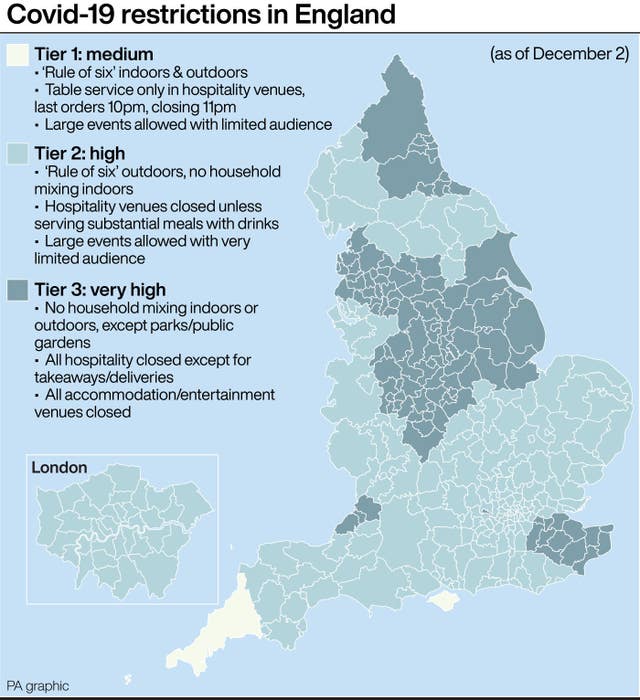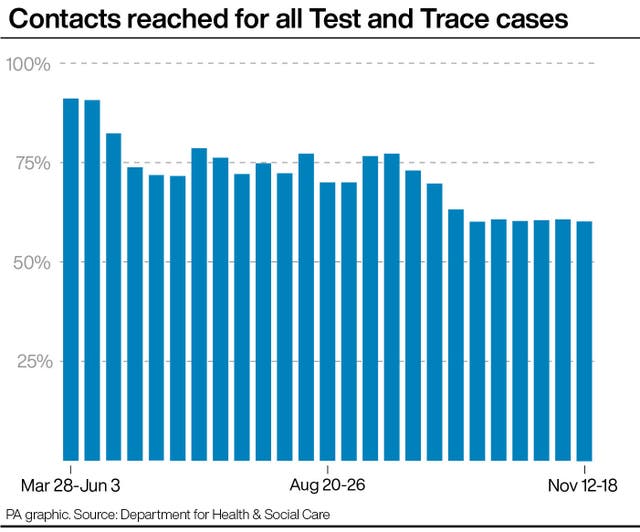More than 55 million people in England will continue to face strict coronavirus curbs after the national lockdown lifts on December 2.
Only the Isle of Wight, Cornwall and the Isles of Scilly – accounting for little over 1% of England’s population – have been placed in the lowest Tier 1 set of restrictions, with all other areas set to face more serious limits to their freedom.
Large swathes of the Midlands, North East and North West are in the most restrictive Tier 3, but the majority of people – including London – will be in Tier 2.
Some 23.3 million people – 41.5% of the population of England – will face the most stringent restrictions, while 32 million people, which is 57.3% of the population, will be in the second tier.
Health Secretary Matt Hancock said: “These are not easy decisions, but they have been made according to the best clinical advice.”
MPs will vote on the new system on December 1, the day before the tiers come into force, and Boris Johnson faces a revolt on the Tory benches over the measures some in the party have deemed “truly appalling”.
In Tier 1, the rule of six applies indoors and outdoors, people are urged to work from home if they can and pubs are limited to table service.
In Tier 2 restrictions include a ban on households mixing indoors, while pubs and restaurants will only be able to sell alcohol with a “substantial meal”.

Tier 3 measures mean a ban on households mixing, except in limited circumstances such as in parks.
Bars and restaurants will be limited to takeaway or delivery services and people will be advised to avoid travelling outside their area.
In all areas, shops and schools will remain open.
Areas placed in Tier 3 from December 2 include:
– In the North East: Hartlepool, Middlesbrough, Stockton-on-Tees, Redcar and Cleveland, Darlington, Sunderland, South Tyneside, Gateshead, Newcastle, North Tyneside and County Durham.
– In the North West: Greater Manchester, Lancashire, Blackpool and Blackburn with Darwen.
– In Yorkshire and The Humber: The Humber, West Yorkshire, South Yorkshire.
– In the West Midlands: Birmingham and Black Country, Staffordshire and Stoke-on-Trent, Warwickshire, Coventry and Solihull
– In the East Midlands: Derby and Derbyshire, Nottingham and Nottinghamshire, Leicester and Leicestershire and Lincolnshire.
– In the South East: Slough, Kent and Medway.
– In the South West: Bristol, South Gloucestershire and North Somerset.
Mr Hancock told MPs: “I understand the impact that these measures will have but they are necessary given the scale of the threat that we face.”
The tier allocations will be reviewed on December 16, with weekly revisions thereafter.
The Government has promised to publish an impact assessment of the measures before MPs vote on them following protests from Tory MPs that economic harm and the knock-on health impacts of restrictions are not being properly considered.
Former minister Steve Baker, leader of the Covid Recovery Group of lockdown sceptics, said: “The authoritarianism at work today is truly appalling.
“But is it necessary and proportionate to the threat from this disease?”
Sir Graham Brady, chairman of the powerful Tory backbench 1922 Committee and a Greater Manchester MP, said: “This is a really heavy-handed approach.”
Former minister Tobias Ellwood said he will not support the Government in next week’s vote after his Bournemouth constituents were placed in Tier 2.
Conservative West Midlands Mayor Andy Street said it is “very disappointing” that the area has been placed in Tier 3, and he demanded more support for businesses forced to close.
The Confederation of British Industry said some firms will be left “hanging by a thread” as a result of the latest restrictions.
The CBI’s UK policy director Matthew Fell said: “Some parts of the economy, such as retail, can begin to reopen and look towards a recovery. It gives our high streets a chance to rescue some of the vital festive trading period.
“But for other businesses, the ongoing restrictions in Tiers 2 and 3 will leave their survival hanging by a thread. Hospitality will remain frozen.”
London Mayor Sadiq Khan welcomed the Tier 2 rating for the capital but added: “There must be no complacency – we know how quickly this virus can spread.”
Andy Burnham, the Labour mayor of Greater Manchester, said the Tier 3 measures in his city will cause “real hardship”.
The mayor, who clashed with ministers over the levels of support available when the region was first put into Tier 3 before the current lockdown, said it is “completely wrong” there is no additional funding.
In other developments:
– The latest figures show a further 498 people had died within 28 days of testing positive for Covid-19 as of Thursday, and there were another 17,555 lab-confirmed cases of coronavirus in the UK.
– A total of 152,660 people tested positive for Covid-19 in England at least once in the week to November 18, according to the latest Test and Trace figures, down 9% on the previous week’s total of 168,250 and the first week-on-week fall since August.

– Just 60.3% of close contacts of people who tested positive for Covid-19 in England were reached through the system in the week ending November 18.
– Covid-19 infections across England are levelling off but there are still wide regional variations, according to the Office for National Statistics, which found around one in 85 people were infected with coronavirus in the week November 15 to 21.
– Guidance in Scotland urges people to have no more than eight people aged over 12 in any Christmas “bubble” they form with family and friends during the UK-wide relaxation of rules between December 23 and 27.




Comments: Our rules
We want our comments to be a lively and valuable part of our community - a place where readers can debate and engage with the most important local issues. The ability to comment on our stories is a privilege, not a right, however, and that privilege may be withdrawn if it is abused or misused.
Please report any comments that break our rules.
Read the rules here